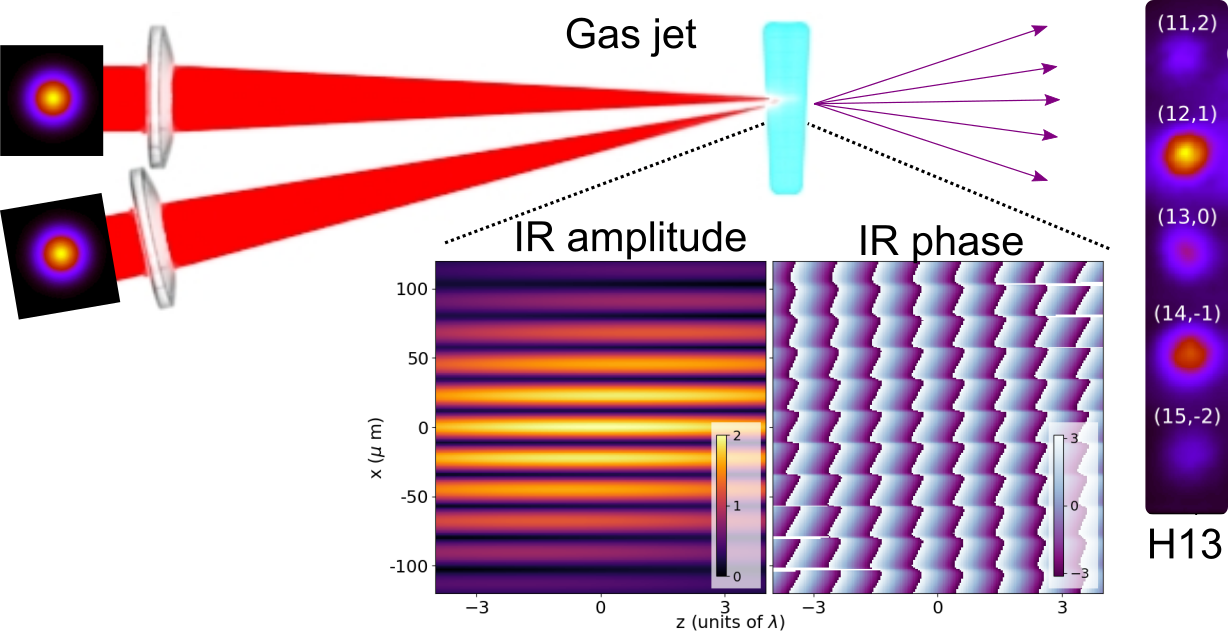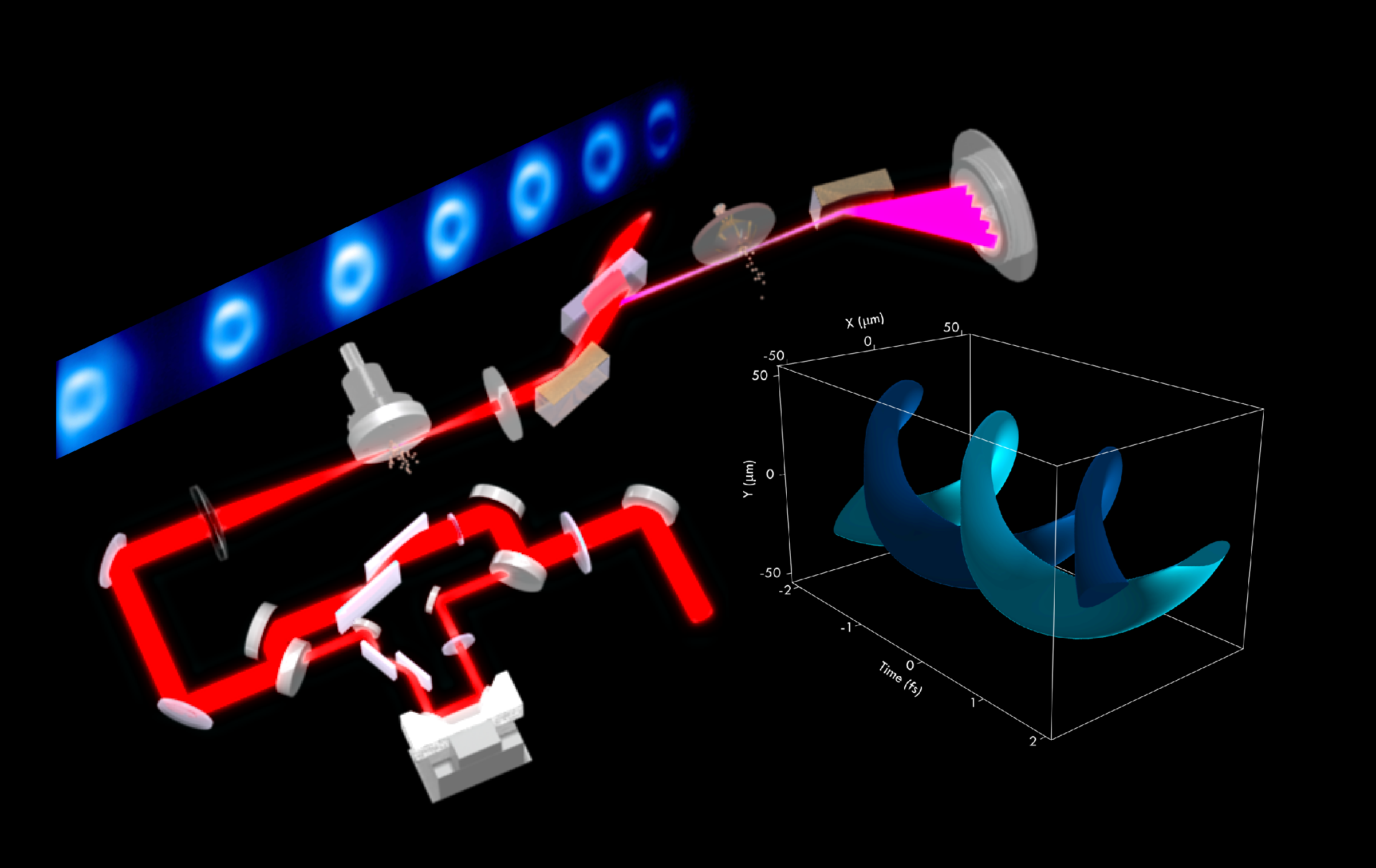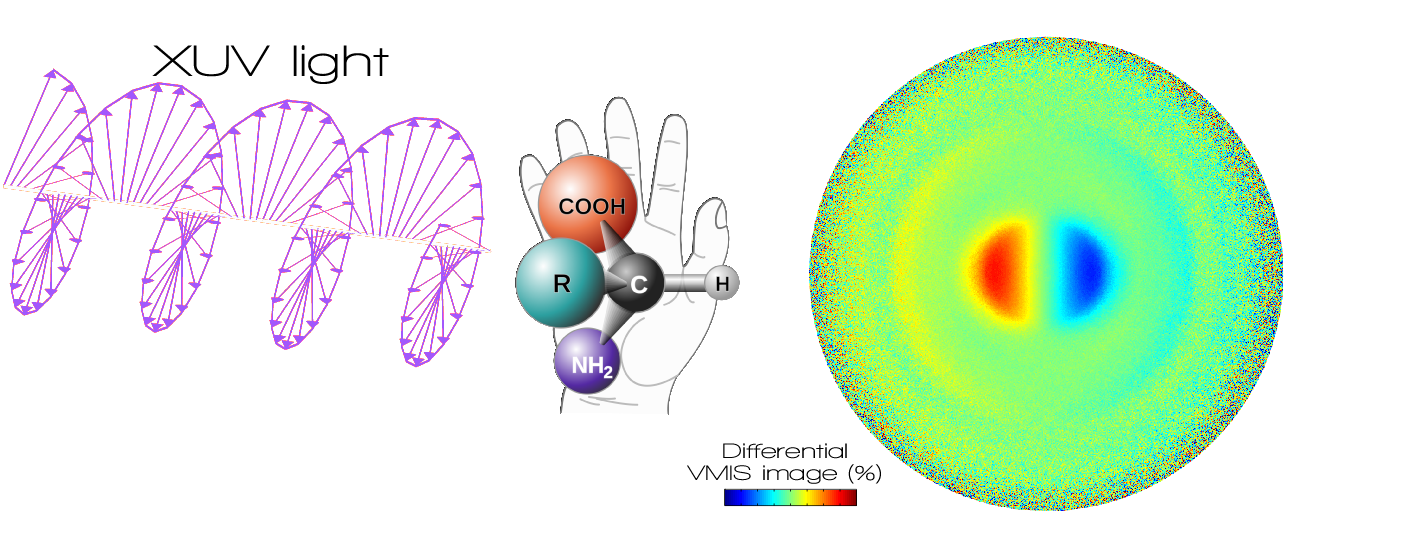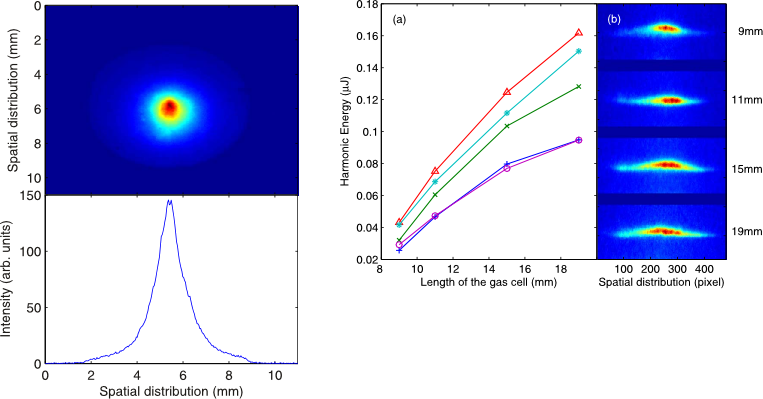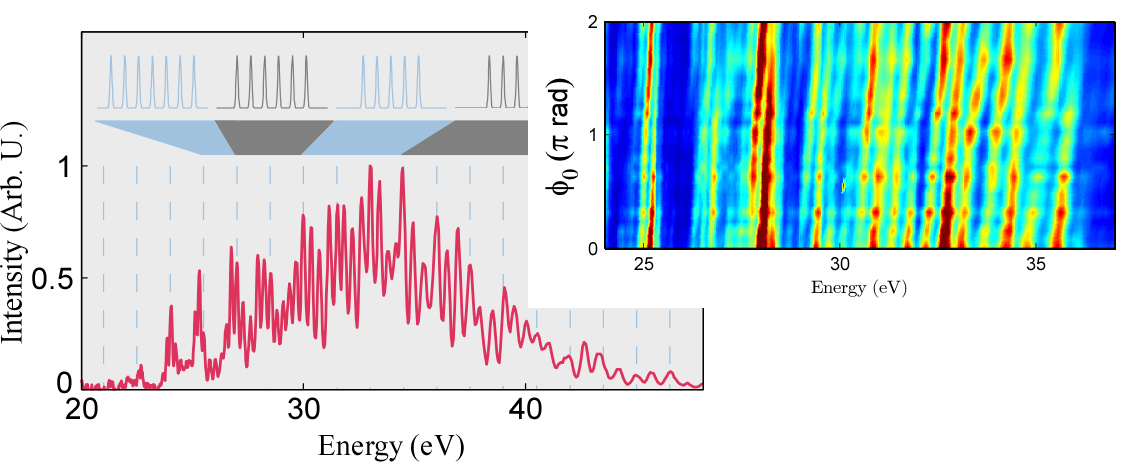HHG driven by two non collinear beams
HHG is usually driven by a single ultrashort laser beam, whose main properties are transfered to the XUV beam. For instance, the direction of emission of the harmonics is perpendicular to the mean wavefronts of the driving laser, the direction of an incoming linear polarization is conserved, the orbital angular momentum is transfered (see below). To get more flexibility, it may look advantageous to use two driving beams instead of a single, with different properties. A case that has long been studied is that of two harmonic beams (e.g. 400 nm and 800 nm wavelengths), propagated collinearly. In a series of experiments we investigated the case of non collinearly propagating beams.
When two driving beams are crossing in an HHG medium, at a given harmonic wavelength, a series of diffraction peaks may be observed. They are spatially split in the plane of the wavevectors of the two driving beams. For harmonic q, they correspond, in a "photonic" picture, to the absorption of n1, and n2 photons from each beam, with q=n1+n2. The spatial split corresponds to the conservation of linear momenta. We have shown that this approach is enlightening but not sufficient to describe all properties of the outgoing spectrum. In particular we proposed and verified a general theory giving the yield of each diffraction order as a function of the angle between the two beams and their relative weights. The main argument is based on the formation of a blazed phase grating by the two driving beams.
XUV beams carrying an orbital angular momentum
Like any massive particle, photons may carry both a spin and an orbital angular momentum. The former is associated to the circular polarisation of a light beam, while the latter is associated to an helicoidal wavefront ( see for instance the review by A. M. Yao and M. J. Padgett). A basis of light beams showing orbital angular momentum is the Laguerre Gaussian beams (see e.g. the presentation by .D. Dounas-Frazer. ). These two types of beams find applications in different situations. In particular, while the spin projection along the propagation axis for paraxial beams is limited to two values, $\pm \hbar$, the orbital angular momentum can take any positive or negative integer value. This leads to capabilities of much denser encoding of information on light beams. For spectroscopic outlooks and imaging outlooks in particular, having at hand XUV beams carrying orbital angular momentum would be invaluable. It is also an ideal situation to test conservation laws derived from quantum mechanics.
We managed to transfer an orbital angular momentum from a visible light beam to the XUV using the high harmonic generation process. These beams have an helicoidal wavefront associated to an azymuthal phase. The phase singularity in the center of the beam leads to a zero of intensity, explaining their "donut" shape. This is was is reported in the figure to the left. We could also measure their "topological charge" and verify the conservation law: harmonic q carries q times the orbital angular momentum of the driving laser. Finally, we could measure their spatio-temporal structure, showing a double helix pattern.
Through a collaboration with the group of Giovanni de Ninno , we could generalized this transfer law to the case of HHG with two beams.
See also the press release on the CEA website Géneaux et al.
In a side experiment with the group of Lou Di Mauro, we could generate very intense MidIR ultrashort laser pulses carrying OAM, directly in an OPA stage. This may open the way to direct synthesis of very high harmonics carrying OAM.
Generation of highly elliptically polarized harmonics
Chiral molecules, which are molecules that can not be superimposed to their mirror image (like the hands for instance), are ubiquitous in nature. Chirality is even sometimes proposed as a condition for the emergence of life. On more practical grounds, the two forms of a chiral chemical usually interact very differently with living organisms. The study of the dynamics of chiral molecules thus carries both fundamental and applied interests.
However, their dynamics at the femtosecond time scale and below is very poorly known, due to a lack of adapted diagnosis tools. In this publication, we show how a tuned HHG source can provide the perfect probe for these molecules, with at least a femtosecond time resolution. More precisely, tuning the polarization state of the driving laser, we managed to generate quasi circularly polarized harmonics. They were used to measure PhotoElectron Circular Dichroism (PECD) in a Velocity Map Imaging Spectrometer. This phenomenon, which is limited to chiral objects, has been largely studied on synchrotron quasi continuous sources ( Desirs com.). Measuring PECD with a femtosecond source now opens the way to time resolved studies.
This research was performed in Bordeaux, in a collaboration between CELIA-Bordeaux, the team of the DESIRS beamline on the SOLEIL synchrotron and the LCAR laboratory in Toulouse.
See also the press release on the CNRS website Ferré et al.
Optimization of a high harmonic source for seeding (work carried out in Lund)
They are currently two mature ultrashort XUV source available for application: HHG-based sources and Free Electron Lasers (FEL). While the former present laser-like properties in term of coherence, divergence and is quite flexible, the latter offers a very high photon flux at the price of a lack of coherence. To combine the qualities of these two sources, a lot of effort is devoted to the "seeding" of a FEL by an HHG source. In this paper we report on the optimization of an HHG source to fulfil the needs for such seeding. In particular, we supply figures for the absolute flux, the divergence and the spectral tuning achievable with an HHG source. This research was performed in the group of Anne L'Huillier in Lund.
Generation of short attosecond pulse trains (work carried out in Lund)
We performed HHG with a two color laser field (800 nm + 400 nm), 12 fs long CEP stabilized. As expected from symmetry considerations we observed the emission of odd and even harmonics. Stabilizing the carrier enveloppe phase of the laser, extra peaks were observed between integer harmonics. Using an analytical model and a full calculation, we could relate their appearance and their number to the number of pulses emitted in the train, which interfere in the spectral domain. Due to the cutoff law of HHG, this number is varying during the pulse, giving an uneven distribution of spectral intensity. These extra peaks shift progressively with the CEP of the laser. These results were obtained in Zürich, through a collaboration between the group of Ursulla Keller and the group of Anne L'Huillier from Lund.
